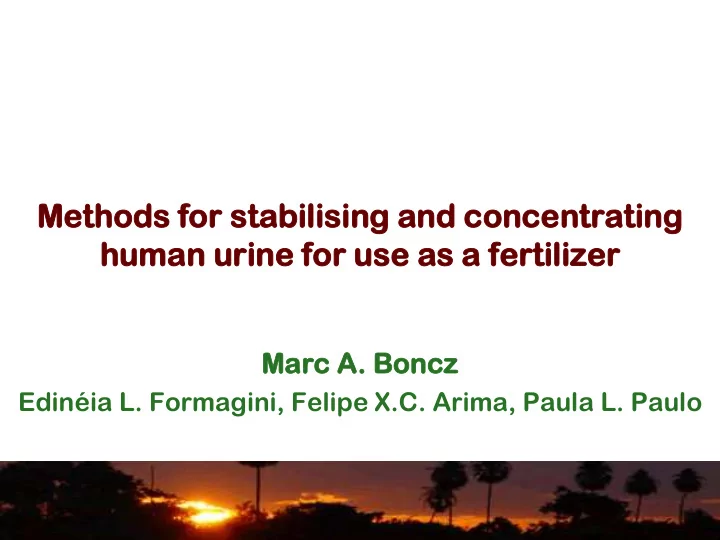

Me Metho thods ds for stab abil ilis ising ing and concen centrating trating hu huma man n ur urin ine e for or us use e as a ferti ertili lizer zer Mar arc c A. Boncz ncz Edinéia L. Formagini, Felipe X.C. Arima, Paula L. Paulo
Introduction • Agriculture in Brazil (and worldwide) • Still growing (population and biofuels!) • Growing dependency on mineral raw materials • Wastewater Treatment • Brazil: mainly UASB reactors • world: often still insufficient nutrient removal
Intro: nutrients for agriculture 35 70% 30 60% Annual fertilizer sales in Brazil (MT) 25 50% imports (%) 20 40% 15 30% 10 20% 5 10% 0 0% 1998 2000 2002 2004 2006 2008 2010 2012 2014 year importação consumo annual
Intro: nutrients for agriculture Other Countries 500 14.0% 450 Egypt 2.8% 400 minério de fosfato ($/ton) Brazil 350 China 3.1% 37.0% 300 Jordan 250 3.4% 200 Tunisia 150 4.3% 100 Russia United States 50 5.7% 14.9% 0 Morocco and Western 1/'60 1/'70 1/'80 1/'90 1/'00 1/'10 1/'20 Sahara ano 14.8%
Introduction: potential of urine • Quantity available much smaller than demand • Higher demand in more densely populated areas 0,50 0,45 Fertilizer sales (ton/ha) south southeast 0,40 0,35 Center/west 0,30 0,25 0,20 northeast 0,15 0,10 0,05 norte 0,00 0 20 40 60 80 100 120 140 160 180 200 Population density (inhab./km 2 )
Main problem: instability of urea • Urea hidrolysis: 16 H 2 N-CO-NH 2 + H 2 O 2 NH 3 + CO 2 14 + + OH - NH 3 + H 2 O NH 4 12 v max,hydrolysis (mmol.L -1 .min -1 ) • Enzymatic process 10 • Faster at pH ≈ 7 8 6 • Problems: 4 • Loss of Nitrogen • Smell 2 • Increase of pH 0 3 4 5 6 7 8 9 10 pH
Objectives • stabilizing human urine for use as a fertilizer • Conservation of nutrients contained • impeding mainly urea hydrolysis • Volume reduction • Reduction of transportation costs
Materials and Methods • Fresh urine collection + characterization • pH, TN, NH 3 , P, K, TS, VS, FS • Addition of stabilizing compounds • acids, NaOH, limestone, ashes or a mixture • Determination of initial weight • Storage in temperature controlled room or greenhouse – with and without forced ventilation ( determination of evaporation) • Parameters followed: • Weight, TN, NH 3 , P, K, TS
Materials and Methods
Results: evaporation • Slightly slower when compared to water • Influenced mainly by the TS contents 35 35 30 30 Rate evap (g.d -1 ) 25 25 Rate evap (g.d -1 ) 20 20 15 15 10 10 5 5 0 0 0 5 10 15 20 25 0 10 20 30 40 time (d) Conc. factor 35 35 30 30 25 25 Rate evap (g.d-1) Rate evap (g.d -1 ) 20 20 15 15 10 10 5 5 0 0 0 20 40 60 80 100 0 10 20 30 40 ambient temp. (oC) rel. humidity (%)
Results: hydrolysis pH development during the experiments 14 1 - Urina 2 - H2SO4 3 - HCl 4 - HAc 5 - NaOH 12 10 pH 8 6 4 2 0 1 2 3 4 5 6 7 8 9 10 11 12 13 14 15 16 17 18 19 20 21 22 23 24 25 Time (days)
Results: acid preservation 6,0 AS1 AS2 AS3 ASF AA1 AA2 AA3 AAF 5,0 4,0 3,0 2,0 pH 1,0 0,0 0,0 2,0 4,0 6,0 8,0 10,0 12,0 14,0 16,0 18,0 20,0 -1,0 -2,0 tempo (d) acids: 0.065 ... 0.27 M
Results: nutrient recovery • Nutrient recovery: • Nitrogen – compatible to the capacity of the maintenance of a high or low pH • K mostly 100% • Results for P are comparable to N N P K N P 120% 140% recovery (%) 100% recovery (%) 120% 100% 80% 80% 60% 60% 40% 40% 20% 20% 0% 0% U AS AC AA AS1 AS2 AS3 ASF AA1 AA2 AA3 AAF
Conclusions • It is possible to preserve the nutrients in the urine by using acids or bases. • Better results obtained with acids (lower loss of nitrogen) and easier to implement (e.g. use of vinegar). • For the case of bases, better results were obtained by using limestone. can be used to improve quality of soil + - Significant increase of the weight of produced fertilizer
Tha hank nks s for or th the e at atte tention ntion! marc.boncz@ufms.br paula.paulo@ufms.br Acknowledg knowledgments ments CNPq – project number 475650/2009-3
Recommend
More recommend